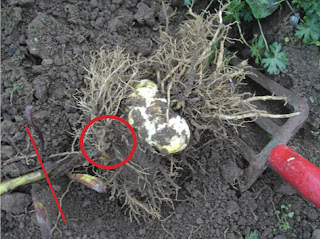 |
| 'Zambesi' - Fresh white flowers & pollen just beginning to "open". |
Kathy, a gardener who loves her lilies in the greater Seattle area, sent us an email in November asking for help with pollen stains on her wool sweater. A day later, when asked if she could write a short story and document the pollen removal with photos, she reported that even after a a single day of exposing the fabric to sunshine, the stain had already shrunk too much to make dramatic photos.
Good work, Kathy!
(All photographs by B&D Lilies.)
Kathy's "Winter" Lily Pollen Report
"Here I am in the kitchen cooking away
with a beautiful vase of lilies on the counter. They smell so
wonderful. Now, I've heard pollen does not come out of fabric and I
should be cutting off the anthers where the pollen dust sits. Problem
is, I've also been told the fragrance is emitted from the anther.
True, False, I don't know. For this story it's true because that's
the reason I had not cut the anthers off.
Back to dancing around the kitchen
because I'm cooking a great dinner for a special person. As I dip and
turn I realize I'm close to brushing up against the lily, I panic and
try to dodge it, but my arm sweeps by the anthers getting covered
across the whole upper arm. I immediately take the wool sweater off
and flush it with water with nothing happening. Adding dish soap and
rubbing between my hands only makes it spread. I stop. Ring it, pat it, and PANIC!
I run to the computer to hunt for any
information on the web. Everyone recommended the sun on a sunny day.
They also had fabric like cotton and linen. I have wool, it's winter
and I live in the Pacific Northwest, which means no sun.
Taking a chance. I put the sweater in a
single pane window that had morning light, not sun light. Next
afternoon when I had time to get back to the sweater the spot looked
a little diminished. As it set in the window over the next month
little by little the spot has disappeared.
Lessons:
- The sun works on materials of cotton, linen, wool and probably many others
- Natural Light over a longer period of time works too.
- The fragrance comes from the anther, pistil and even the petals.
- Don't touch the area that was brushed by the anthers. Let it dry and brush it off in a day or two with a soft brush. Tape also works if you don't have a brush."
Further Notes from Dianna
 |
| 'Corcovado' OT - anthers "closed", Style moist. |
- When a lily flower first opens, the anthers are moist and tightly closed. As the day progresses, they unfurl, exposing the pollen grains.
- Petal tips have the greatest concentration of fragrance oils, so sniff the edges of a fully opened flower for the best scent. The center of the lily, where the reproductive parts are located, can be removed without any loss of perceived fragrance.
- The "Style", which ends in a three part "knob" and drips sweet-tasting stigmatic fluid, also exhibits light scent, and in the case of a large purebred Oriental lily, can sometimes plentifully run down the bottom petal. This sticky protrusion helps to hold the pollen from other varieties tightly to the Style, as hummingbirds, bees and other insects brush against it. This is how new hybrids are created from the resulting seed—produced later in the summer between compatible plants, if the growing season is favorable.
 |
| Can you see the pollen grains? (Hint: Look at the texture.) |
- Pollen is generally sticky, even when "dry", which is the reason why you should never try to brush pollen off with your hand; the natural oils present on your skin will smear and "set" the pollen into fabric, or simply beautify your skin with a lovely orange-yellow cast.
- If pollen is on your skin, such as an arm, flicking a soft cloth or brush on the grains can generally remove it. In the field, we've used the end of a clean tractor towel to knock the pollen off jeans, not nearly as effective as a brush, but good for emergencies.
- It is a simple thing to gently pull off the dangling anthers with your fingers before they fully open, or use a tissue to remove open ones and keep your fingers from turning yellow. With a dry artist brush, you can sweep off any dropped pollen grains on the petals to tidy the flower, but only if the petals and pollen are dry. Lily pollen grains are generally too sticky and large to blow around upon the wind, so generally do not affect those with sensitivities to spring and summer pollen, and for those of us with fragrance allergies, unscented lilies are generally preferred for indoor use.
 |
| 'Little Yellow Kiss' |
 |
| 'Miss Lucy' |
 |
| 'Polka Dot' - a Spring 2014 Introduction. |
- Don't want to go to the bother of picking off pollen to bring the stems indoors for vases? Choose one of the pollen-free varieties, such as 'Little Yellow Kiss' (Asiatic) or one of the fluffy and fragrant Double Orientals for your home. The anthers are either not completely formed—hidden completely inside the petals—like 'Miss Lucy' or do not naturally produce a significant amount of pollen beyond a few grains.





























